Excerpts from Jim Conrad's
Naturalist Newsletter
entry dated April 22, 2023, issued from near Tequisquiapan; elevation about 1,900m, (6200 ft), ~N20.57°, ~W99.89°; Querétaro state, MÉXICO
(~N20.55°, ~W99.89°)
HOW I IDENTIFIED A GRAY BIRD GRASSHOPPER
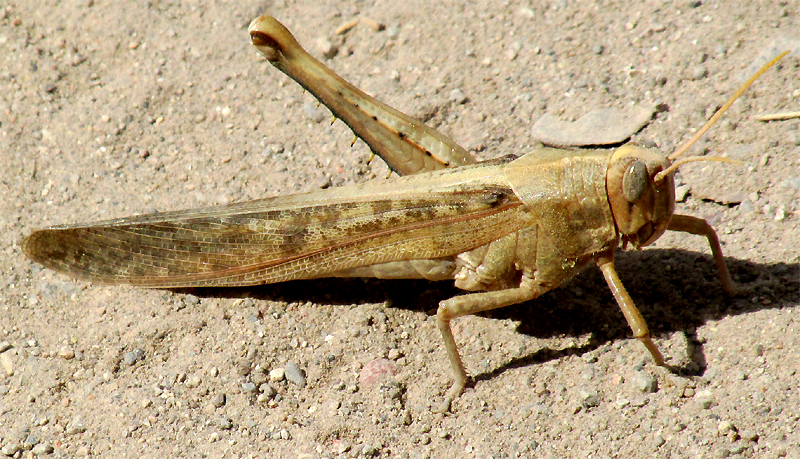
On a dusty dirt road leading out of a small village, the above grasshopper caught my attention because of its large size and slenderness. While taking the above picture, a truck came down the road, the grasshopper and I both fluttered aside, and I never got a good side view of the thick part of the grasshopper's back leg, the femur, because on our individual the hind leg on this side of the body was missing. Here's how I identified this rather plain-looking grasshopper in this out-of-the-way part of the world:
I began with the BugGuide.Net website. BugGuide considers North American insects, but other countries worldwide have the same insect orders and often the same families. Even outside North America where different species may be expected, BugGuide can help determine an unknown insect's order, probably the family and, here in nearby Mexico, often the genus, and sometimes even the species.
On BugGuide's entry page, on the "Clickable Guide" at the left of the page, I clicked on the grasshopper drawing. That took me to a BugGuide page under the Info tab (the tab highlighted at the top of the page), which informed me that grasshoppers, crickets and katydids all are members of the Order Orthoptera. On that page sample pictures of members of the order indicated the general similarity of them all. Then I clicked on the Browse tab.
Now by matching pictures I was helped to determine which suborder our grasshopper most likely belonged to. There were only two suborders, and I clicked on the Suborder Caelifera -- Grasshoppers. This led to the page for choosing which of five families our unknown belonged to, each family illustrated by photos. I knew that colors varied enormously, so structural features were most important to notice. Our grasshopper was particularly long and slender, plus the outer tips of its folded wings tapered more to a narrower point than on most species. One picture was most similar to ours, and it was in the Family Acrididae -- Short-horned Grasshoppers. So I clicked on that.
On the next BugGuide page, for choosing the subfamily, really I couldn't decide just by looking at the pictures. It was time to change gears. Now I went to the GBIF.Org, the letters GBIF standing for "Global Biodiversity Information Facility." Atop the entry page I clicked the magnifying-glass/lollipop icon,and in the resulting search box wrote the family name attained from BugGuide, "ACRIDIDAE." That sent me to GBIF's page with links to various other pages dealing with the Acrididae. At the top was a link with a world map at the right, titled simply "Acrididae," and I clicked on it.
GBIF's Acrididae page told me that GBIF had at that moment 2,405,999 documented occurrences of Acrididae worldwide, and recognized 6,917 Acrididae species worldwide. Farther down the page appeared a world map with yellow, orange and red dots wherever the family had been documented -- which was nearly everyplace. Red dots indicated many occurrences. On my computer the map can be moved by holding down the left click button while pushing the map around with the cursor. I centered the map on Mexico, then, to zoom in, began clicking the + icon at the map's top, left.
The map had to be repositioned several times to focus on our part of central Mexico. The map doesn't show state boundaries, but by orienting to a big island just off the coast in the Gulf of Mexico to our east, and rivers and lakes, I kept clicking on + and repositioning the page until only about 15 dots representing documented occurrences of the Grasshopper Family were visible. Then at the map's bottom, right, I clicked on EXPLORE AREA.
There, numerous occurrences of maybe 7 or 8 species in different genera were listed, the most commonly occurring being Schistocerca nitens. On the Google Image Search Engine a search on the keywords "Schistocerca nitens" turned up numerous thumbnails illustrating what seemed to be our grasshopper!
Often it's not as simple as that, but the occurrences map already has told us that in our area this is the most commonly reported Acrididae species, so maybe we were finished. For more confidence in the ID I looked up several other species on the list, but they were obviously different. Then, glancing back and forth between our grasshopper and the picture identified as Schistocerca nitens, I compared in great detail such features as the bodies' general proportions, the narrowness of the tips of the folded wings, antenna lengths, the shapes of the saddle-like part immediately behind the grasshopper's head (the sulcus), the arrangements of dark splotches on the wings and, most closely, venation in the wings. In identification of winged insects, patterns of wing venation are extremely important.
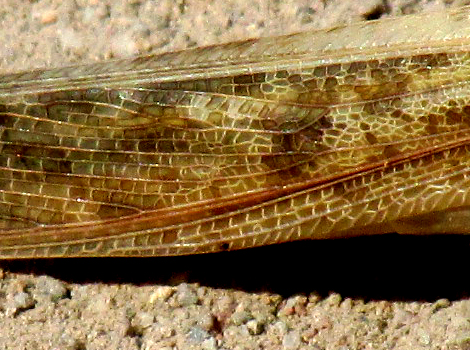
To firm up the ID, I found a close-up picture of Schistocerca nitens identified by an expert. There I saw that all the forked veins seen above, and all the cells formed by cross-veins, matched almost perfectly. A few small cells were slightly differently shaped, but the GBIF map of Schistocerca nitens occurrences -- use GBIF's magnifying glass icon to search on the name -- shows that the species is widely distributed from the southwestern US south to northern South America. Over such a large distribution area, geographical variation such as slight cell shape changes in wing venation can be expected. Moreover, in the above picture, the dark splotches appeared exactly in the same cells as in the wings of the expertly identified picture of Schistocerca nitens.
So, SCHISTOCERCA NITENS. Having that name, we can look it up and see what's interesting about it. Wikipedia's Schistocerca nitens Page tells us that two common English names for our grasshopper is Gray Bird Grasshopper and Vagrant Grasshopper. It's closely related to the famous Desert Locust, for which a link is given. "It lives in many habitats including desert, woodland, and lower elevation mountainous areas," Wikipedia tells us, and it reaches lengths of up to 7cm (2¾ inches) in length. Sometimes it's considered a pest because it feeds on ornamental plants and many types of crop plants.
Yet another approach to identifying our grasshopper -- less technical and more reliant on photos -- could have been taken by using the iNaturalist.org website. That website is international in scope, and there's a search bar accessible by the magnifying-glass/lollipop icon at the entry page's top. To begin our ID quest, I could have done a web search on the keywords (using the Spanish word for "grasshopper")"chapulines mexico inaturalist." That would have given me a link to the Chapulines, Langostos y Grillos de México iNaturalist page for grasshoppers, katydids and crickets of Mexico. That page works similarly to the others we've visited, just more dependent on pictures.
The above websites haven't been available during most of my life. If I'd had them, my IDing and learning about local plants and animals would have been very much easier. Who knows what that would have led to? Moreover, the future surely holds even more remarkable possibilities for learning about Nature in our own backyards.
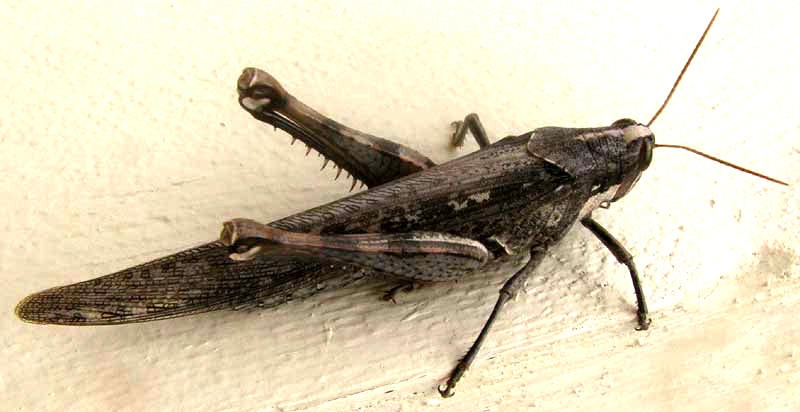
from the April 27, 2014 Newsletter issued from the Frio Canyon Nature Education Center in the valley of the Dry Frio River in northern Uvalde County, southwestern Texas, on the southern border of the Edwards Plateau; elevation ~1750m (~5750 ft); N29.62°, W99.86°; USA
GRAY BIRD GRASSHOPPER
Clinging to the wall of my neighbor Phred's garage one morning this week was the largest grasshopper I've seen in this area, about 2¾ inches long (7cm), shown above. A picture better showing the distinctive white patches on the face and the front part of the thorax, the pronotum, and the handsome chevron pattern on the hind leg's femur, is shown below:
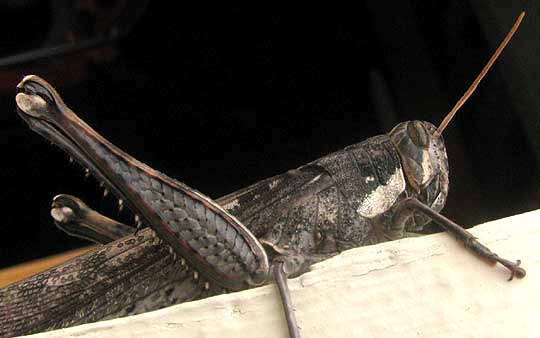
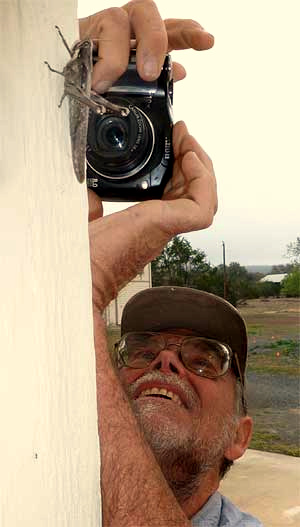 And just for fun, a picture taken by Phred of me taking the above pictures appears at the right.
And just for fun, a picture taken by Phred of me taking the above pictures appears at the right.
By looking at grasshopper pictures at BugGuide.Net, volunteer identifier Bea in Ontario figured out that this might be the Gray Bird Grasshopper, or Vagrant Grasshopper, SCHISTOCERCA NITENS. My further checking on the species found that the species is commonly seen in this area and is to be expected, so that's what I'm calling it. Gray Bird Grasshoppers are mostly a tropical species, occurring from northern South America up through Central America and Mexico, and entering the US from California to Texas and Oklahoma.
Gray Bird Grasshoppers are solitary and non-migratory, but under certain conditions they form swarms that fly long distances and cause damage to crops and native plants. They've been introduced into Hawaii, where in 2002 and 2004 outbreaks on the island of Nihoa led to the defoliation of almost all the vegetation, including endangered plant species.
The name "bird grasshopper" is applied to members of the genus Schistocerca, apparently because of their large size, approaching that of small birds.